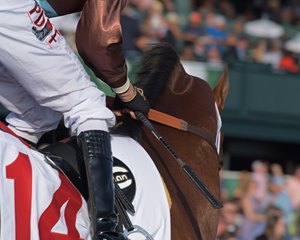CHRB Passes Riding Crop Regulations, Awards Race Dates


During a contentious, lengthy teleconferenced meeting of the California Horse Racing Board June 11, regulators passed riding crop specifications and restrictions on their use, and approved race dates that will result in fair racing for six weeks this summer in Northern California.
The CHRB passed a long-tabled proposal that will mandate California jockeys utilize a circular foam-tipped riding crop, such as the 360 GT crop designed by retired Hall of Fame jockey Ramon Dominguez. The passage came despite opposition from jockeys on the conference call and from the Jockeys' Guild representatives.
Additionally, the board advanced previously passed regulations after a 45-day waiting period for public comment that will limit jockeys to striking a horse two times in succession—not to be raised above the shoulder—before a pause for a response, with a maximum of six strikes. That regulation, first passed in December, could now be implemented as early as October.
Mike Smith and Aaron Gryder were two of the jockeys who opposed the CHRB's measures, with Smith calling the dimensions of the 360 GT uncomfortable for changing hands while riding. Both riders expressed a preference for the cushion crop currently in widespread use. They claimed these are the most popular with the overwhelming majority of riders.
They and guild representatives expressed a concern that mandating a circular foam-tipped riding crop would restrict options for riders and could potentially create a monopoly.
"I am not against anybody ever coming in and bringing other ideas, but I don't believe everybody has to drive a Toyota car when they go on the freeway," Gryder said.
Without edges, circular foam-tipped riding crops are marketed as being kinder, and test results delivered to the CHRB indicated lower measurable impact from 360 GT crops compared to standard crops. Those test results were generated by NTS-Chesapeake under contract from The Stronach Group, which operates Santa Anita Park and Golden Gate Fields in the state.
In March 2019, following a spike in equine fatalities at Santa Anita, Belinda Stronach, the chairman and president of TSG, called for a ban of the whip.
"This crop is much more humane. I think it's the only reasonable thing to do," CHRB chairman Dr. Greg Ferraro said before calling for the passage of the required regulations. "If we are going to have some leadership in California, we need to pass this rule and let the rest of the nation follow our lead.
"We're never going to please the jocks. They don't want to do anything but keep the status quo. I appreciate their argument, but it's not going to fly in the face of public demand that we quit hitting these horses."
Those comments were met with pushback from riders and their representatives, who said they had been at the fore of seeking compromise on reform. Jockeys' Guild representatives asked for four to six weeks before the board take any further action toward the riding crop, seeking to develop a plan that mirrors one they hope to make with the Thoroughbred Safety Coalition.
Some commissioners wanted to table the action, awaiting developments nationally, but the adoption of the riding crop restrictions passed 4-2 when presented with the potential it could delay implementation and California Gov. Gavin Newsom's directives to the board to institute change.
Anti-racing protesters again held up the CHRB meeting with public comments, largely calling for the end of the sport, but the CHRB was further delayed by a fight over Northern California race dates. California Fair leaders, horsemen representatives, and Aidan Butler, the acting executive director of California operations for TSG, sparred. If Pleasanton was awarded dates, summer dates it historically receives, Golden Gate initially desired to close its facility for training, where approximately 1,300 horses are stabled.

After needing a private meeting amid the CHRB conference call to try to reach a resolution that the board would find acceptable, fair officials and TSG agreed to have Pleasanton run a shortened six-week season, including fair dates. They will race from June 17-July 28, after which Golden Gate will pick up an extra week of racing.
Even with an agreement and with training permitted at Golden Gate, it was not met happily by some horsemen and their representatives who participated in the conference call. A large number had signed a petition asking for racing at Golden Gate.
Ian McLean, a Thoroughbred owner and breeder who races in Northern California, wanted racing and training this summer at Golden Gate and not racing at Pleasanton, which traditionally runs in the summer. He expressed concern to the CHRB about health dangers related to the virus that could be amplified by vanning horses to a different racing location from their training base.
"Maybe sometime in June, we can have a CHRB day where the CHRB joins us down at Golden Gate Fields. We'll load up in some trucks, caravan over to (Pleasanton), spend the day mixing and milling, just as you're asking (horsepeople) to do," he quipped. "Then travel back home and then go home and kiss and hug their families."
Though discussions of Northern California racing were the most fiery in Thursday's meeting, Del Mar and California Thoroughbred Trainers representatives also expressed displeasure with one another over the lack of a signed horsemen's agreement. They are at odds over the fair procedure in the case of a dispute between a racetrack and a trainer, such as what unfolded in 2019 when TSG excluded Jerry Hollendorfer from its properties after he had four breakdowns at Santa Anita during its winter/spring meet.
The CHRB granted Del Mar its summer race dates, applying the previous contract between the parties. A signed horsemen's agreement is required by California regulations.
